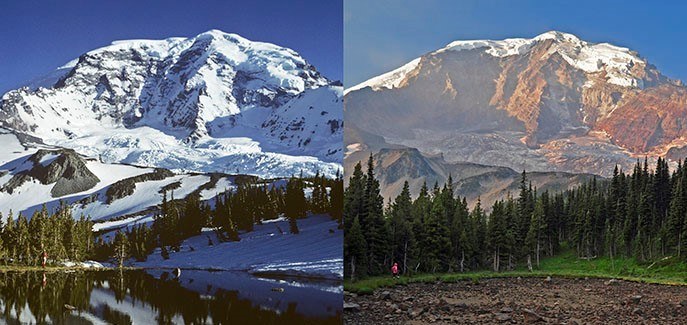
I first set foot on Mount Baker’s Coleman Glacier in August of 1972, accompanied by my friend Mary Bramble. Mary and I met two years before climbing Glacier Peak with the Mazamas, and had done some hiking and climbing since. ‘72 was also the year I had begun climbing outside the club (to the anxiety of my parents), with friends who possessed the same desire to lead climb on more difficult peaks.
Mary and I had ice axes and crampons, and with our limited skill wanted to explore the smaller crevasses and jagged seracs near Observation Rock. The glacier was pretty close to the rock at that time, and over the next 49 years I would watch it melt away, receding in length, width, and thickness. After every trip on the ice I would read more and more about how glaciers were created and what their behavior is like, which is not dissimilar to a living organism.
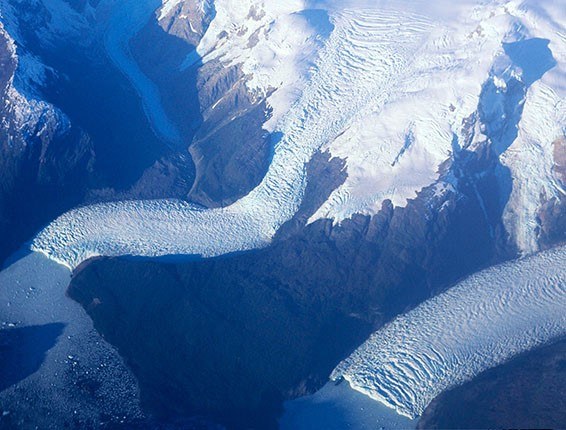 An aerial photo of tidewater glaciers and the North Patagonian ice field, Chile. All photos courtesy of Alan Kearney.
An aerial photo of tidewater glaciers and the North Patagonian ice field, Chile. All photos courtesy of Alan Kearney.
Glacier ice is snow that has melted, condensed, and recrystallized under pressure, over time becoming the harsh and hard substance that it is. With enough gradient and mass the body of ice will begin to move, and only then truly becomes a glacier. Snowfall in the glacier’s upper zone must be sufficient, and cooler temperatures are needed for it to persist. At present this is not happening for the majority of glaciers worldwide.
Imagine a natural mechanism that stores fresh water and disperses it carefully over the course of each year, so that land-based life on Earth can utilize it. Glacial till provides soil for growing crops, and the great bodies of moving ice have shaped the surface of our planet. Deep U-shaped valleys, gigantic lakes, sinuous ridges, and striking peaks are just a few examples of the power of carving ice. And now more than ever, glaciers throughout the globe have become crucial indicators of climate change, which in actuality is “climate disruption.” Glaciers have come and gone during the planet’s history, but never have they melted so rapidly as now, due to the increased CO2 pumped into the atmosphere by all of us. I am not a geologist or glaciologist, but I am a very keen observer who always carries a camera. From decades of mountaineering I’ve had a front row seat to what’s happening to our glaciers.
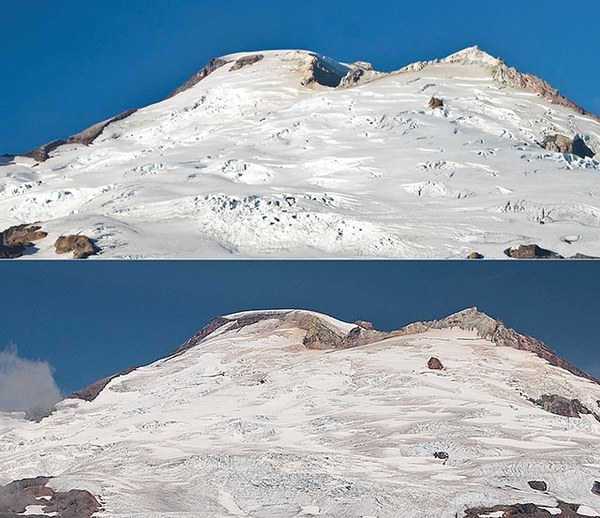 Comparison of the Upper Easton and Squak Glaciers of Mt. Baker. Taken August 2012 (top) and 2021.
Comparison of the Upper Easton and Squak Glaciers of Mt. Baker. Taken August 2012 (top) and 2021.
To travel safely on a moving body of ice requires special skills, and a knowledge of the unusual terrain. Between late 1972 and 1980 I climbed extensively in the Cascades, Sierras, and Alaska, acquiring the techniques needed to spend a life on the ice. In 1980 I began what would become 19 years of teaching ice climbing on the Coleman and Easton Glaciers, leading people to the summit. By the mid-1990s I transitioned into doing photography and writing full time, and have continued to teach ice climbing as a volunteer for The Mountaineers since 2003. I just can’t stay away from what I consider one of earth’s most amazing and beautiful landforms.
I always wanted to climb the most striking mountains, the ones that appeared insurmountable from every side. Of course it was those same peaks that owed their appearance to the action of glaciers. As the years passed I became more proficient on snow, rock, ice, and larger committing alpine faces, and sought out those savage fangs and slender citadels I had dreamed about as a kid. You cannot view those iconic summits like the Central Tower of Paine, Cerro Torre, Mount Assiniboine, and the Matterhorn, and not think about the glacier as a sculptor.
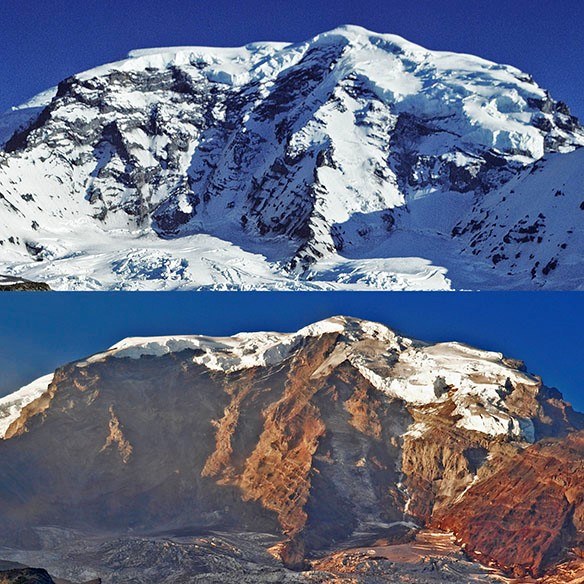 An ice cliff comparison on Mt. Rainier’s North Face, in 1976 and 2021.
An ice cliff comparison on Mt. Rainier’s North Face, in 1976 and 2021.
My love for glaciers and concern about the state of our earth led me to begin documenting glaciers in Washington in 2006. Using my photos from the 1980s, I have returned to the exact photo locations on foot, armed with a color print and my camera. This summer in July I was driving I-5 home to Bellingham when I noticed with the naked eye, from many miles away, bare rock clear across the top of Mount Baker’s Roman Wall. In early August Gregg Oliveri joined me to document the Easton Glacier from Park Butte. Like me, Gregg has spent many hundreds of days climbing on and skiing Mount Baker’s glaciers. We were astounded by what we saw. Mount Baker’s slightly above-average snowfall last winter could not hold its own against the heat wave of our 2021 summer.
Beginning in 2015, I have noticed dramatic changes in our glaciated alpine environment that we need to pay attention to. It’s as if the climate were a giant blow dryer turned on high: a block of freezer ice on your summer deck would fare no better than our glaciers do. As these glaciers rapidly melt, more crevasses appear, and when the ice moves around a rock bulge it breaks up even more. Crevasses that occur in the same place every year (like the big one at 8,800 feet on the Coleman Glacier) are opening up wider and sooner in the season, making travel more difficult.
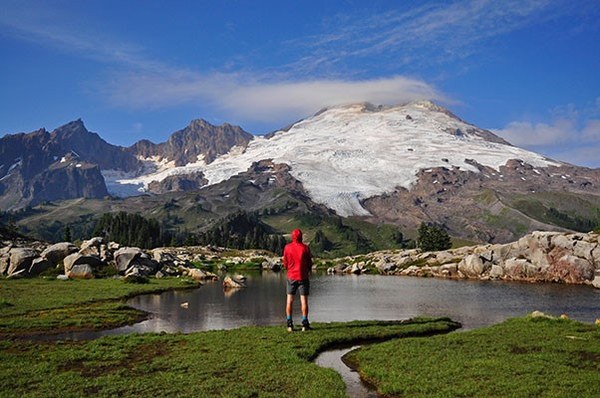 Gregg Oliveri viewing the Deming, Easton, and Squak Glaciers from below Park Butte, Mt. Baker, in 2021.
Gregg Oliveri viewing the Deming, Easton, and Squak Glaciers from below Park Butte, Mt. Baker, in 2021.
In places now there is bare rock often covered with loose gravel, and what remnant ice remains is steeper and narrower than before. Such is the case on the Ptarmigan Traverse where one accesses the Le Conte Glacier. In 2015 friends and I chose to do the traverse in July, and I brought some small wired stoppers and one ice screw. The tiny cracks on the adjacent metamorphic cliff accepted the small nuts, and higher on the narrow lobe of the glacier, one ice screw. We made it, but later in August a group turned back as they had brought no protection at all.
Rockfall and icefall is also increasing. Without seasonal snow or ice holding together the matrix of rotten rock on certain routes, it falls down. Ice cliffs and seracs are more dangerous than ever. The ice cliff on Colfax Peak (one of the Black Buttes on Mount Baker) had a crack clear across it in June of this summer, collapsing dramatically in July. Seracs that form in icefalls can topple at any time of day or in any season, however they are much more likely to fall over in the heat wave we experienced, especially when it does not freeze at night at 6,000 feet.
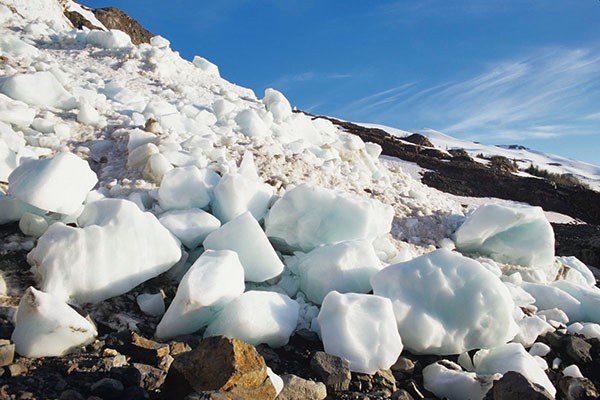 Evidence of a recent icefall below the snout of the Roosevelt Glacier, Mt. Baker.
Evidence of a recent icefall below the snout of the Roosevelt Glacier, Mt. Baker.
Aside from the obvious ramifications of the warming climate affecting our daily lives, how should we as climbers make decisions to continue trudging up mountains and stay safe? You might have to pick an alternate route on your chosen peak, or even change your objective. In 2021 the Bellingham Branch of The Mountaineers chose not to climb the Easton Glacier on Mount Baker, and opted for a climb of Mt. Shuksan instead. If you travel frequently in the alpine realm as I do, you know these conditions to be true.
We cannot save the glaciers at this time, but like a dying friend or loved one, we can be by their side and spend time with them. Visit them, climb or walk on them if you can, and look around and appreciate what they have given us. When the white and blue ribbons of winding ice are finally gone the mountains will remain, but denuded of their icy mantle, they will have lost some of their allure. I for one will be very sad at the passing of my old friends, who have nourished three-fifths of my life.
The photos I have from 1981 through this last summer will become a part of a book I began writing last winter, Glaciers I Have Known. Throughout its pages I will explain what glaciers are and how they behave. I’ll share the stories of my greatest climbs where we crossed glaciers to reach our chosen peaks, and how their perfect symmetry was honed by moving ice. In the last third of the book I will include detailed descriptions and maps on how to hike or climb to the glaciers I have been photographing.
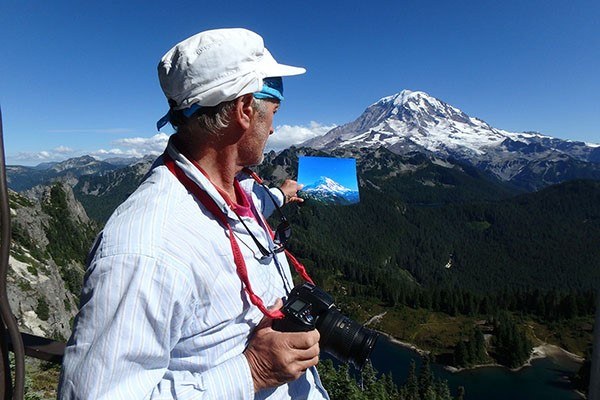 Alan On Tolmie Peak in 2015 with print of Rainier in 1993.
Alan On Tolmie Peak in 2015 with print of Rainier in 1993.
To see and hear more from Alan Kearney on glaciers, follow him on Instagram @kearneysglaciers.
 Alan Kearney
Alan Kearney